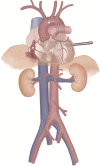State-of-the-art methods for the treatment of severe hemorrhagic trauma: selective aortic arch perfusion and emergency preservation and resuscitation-what is next?
- PMID: 33791103
- PMCID: PMC7995927
- DOI: 10.1002/ams2.641
State-of-the-art methods for the treatment of severe hemorrhagic trauma: selective aortic arch perfusion and emergency preservation and resuscitation-what is next?
Abstract
Trauma is a primary cause of death globally, with non-compressible torso hemorrhage constituting an important part of "potentially survivable trauma death." Resuscitative endovascular balloon occlusion of the aorta has become a popular alternative to aortic cross-clamping under emergent thoracotomy for non-compressible torso hemorrhage in recent years, however, it alone does not improve the survival rate of patients with severe shock or traumatic cardiac arrest from non-compressible torso hemorrhage. Development of novel advanced maneuvers is essential to improve these patients' survival, and research on promising methods such as selective aortic arch perfusion and emergency preservation and resuscitation is ongoing. This review aimed to provide physicians in charge of severe trauma cases with a broad understanding of these novel therapeutic approaches to manage patients with severe hemorrhagic trauma, which may allow them to develop lifesaving strategies for exsanguinating trauma patients. Although there are still hurdles to overcome before their clinical application, promising research on these novel strategies is in progress, and ongoing development of synthetic red blood cells and techniques that reduce ischemia-reperfusion injury may further maximize their effects. Both continuous proof-of-concept studies and translational clinical evaluations are necessary to clinically apply these hemostasis approaches to trauma patients.
Keywords: Emergency medicine; hemorrhagic shock; ischemia‐reperfusion injury; oxygen carrier; torso hemorrhage; traumatic cardiac arrest.
© 2021 The Authors. Acute Medicine & Surgery published by John Wiley & Sons Australia, Ltd on behalf of Japanese Association for Acute Medicine.
Conflict of interest statement
Approval of Research Protocol: Not applicable. Informed Consent: Written informed consent was obtained from the patient for publication of this case report and accompanying images. A copy of the written consent is available for review by the Editor‐in‐Chief of this journal on request. Conflict of Interest: None declared.
Figures
Similar articles
-
A comparison of Selective Aortic Arch Perfusion and Resuscitative Endovascular Balloon Occlusion of the Aorta for the management of hemorrhage-induced traumatic cardiac arrest: A translational model in large swine.PLoS Med. 2017 Jul 25;14(7):e1002349. doi: 10.1371/journal.pmed.1002349. eCollection 2017 Jul. PLoS Med. 2017. PMID: 28742797 Free PMC article. Clinical Trial.
-
Resuscitative endovascular balloon occlusion of the aorta for control of noncompressible truncal hemorrhage in the abdomen and pelvis.Am J Surg. 2016 Dec;212(6):1222-1230. doi: 10.1016/j.amjsurg.2016.09.027. Epub 2016 Sep 30. Am J Surg. 2016. PMID: 28340927
-
Endovascular resuscitation techniques for severe hemorrhagic shock and traumatic arrest in the presurgical setting.J Spec Oper Med. 2013 Summer;13(2):33-37. doi: 10.55460/88CR-K1RG. J Spec Oper Med. 2013. PMID: 23817876
-
Resuscitative Endovascular Balloon Occlusion of the Aorta: Indications, Outcomes, and Training.Crit Care Clin. 2017 Jan;33(1):55-70. doi: 10.1016/j.ccc.2016.08.011. Crit Care Clin. 2017. PMID: 27894499 Review.
-
Novel Methods for Hemorrhage Control: Resuscitative Endovascular Balloon Occlusion of the Aorta and Emergency Preservation and Resuscitation.Anesthesiol Clin. 2019 Mar;37(1):171-182. doi: 10.1016/j.anclin.2018.09.003. Anesthesiol Clin. 2019. PMID: 30711230 Review.
References
-
- World Health Organization . Injuries and Violence. The Facts. 2014. [Accessed 04 Nov 2020]. Available from: https://www.who.int/violence_injury_prevention/media/news/2015/Injury_vi...
-
- Bellamy RF. The causes of death in conventional land warfare: implications for combat casualty care research. Mil. Med. 1984; 149: 55–62. - PubMed
-
- Kauvar DS, Lefering R, Wade CE. Impact of hemorrhage on trauma outcome: an overview of epidemiology, clinical presentations, and therapeutic considerations. J. Trauma Inj. Infect. Crit. Care. 2006; 60: S3–11. - PubMed
-
- Kelly JF, Ritenour AE, McLaughlin DF et al. Injury severity and causes of death from operation Iraqi freedom and operation enduring freedom: 2003–2004 versus 2006. J. Trauma Inj. Infect. Crit. Care. 2008; 64: S21–S27. - PubMed
Publication types
LinkOut - more resources
Full Text Sources
Other Literature Sources



